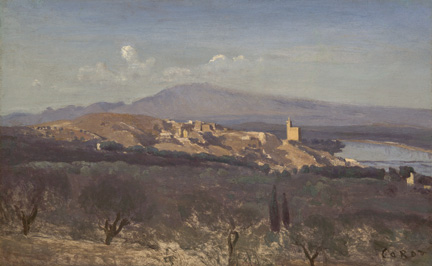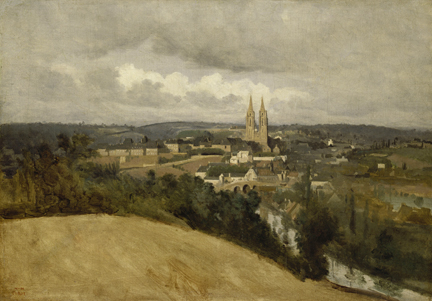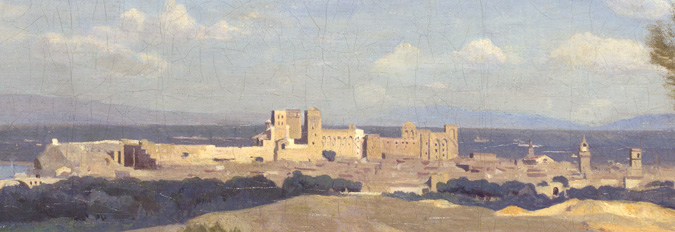Subject
Corot visited Avignon on a number of occasions: in May 1834, in July 1836, when he was accompanied by the Orientalist painter Prosper Marilhat, his pupil Gaspard Lacroix, and the painter Achille-Adolphe Francey, and lastly in 1843. This view is most likely to date from the 1836 visit.
Moreau-Nélaton describes the artists’ routine during their stay in this year: 'The correspondence of Marilhat informs us that the companions installed themselves at Villeneuve-lès-Avignon “where are the most beautiful things to do." "We rose at four in the morning", he writes; "we worked just until eleven o’clock, then we returned to dine like devils…After dinner, we slept until two o’clock, and then we went back until night."'5 During this visit Corot painted a number of plein-air studies which depict either Avignon itself, or Villeneuve-lès-Avignon6.
NG 3237 depicts Avignon from Villeneuve-lès-Avignon, a small town on the other side of the Rhône and a favourite viewing spot for Avignon. Both branches of the Rhône are present on the left, with the Ile de Piot and the Ile de la Barthelasse visible in the middle. On the left are the remains of the Pont Saint-Bénézet, the chapel being faintly delineated.
To the right and above is the Rocher des Domes, where a public garden was created during the Second Empire. The stepped wall comes out from the former Bishop’s Palace, and is still standing. Of the two prominent towers, the one on the left is that of the cathedral (Notre-Dame des Doms), now surmounted by a large statue of the Virgin (1859). The tower on the right and the remaining buildings are part of the Papal Palace, which has been restored since Corot’s time.
Further to the right the tower with a spire is that of the church of St Pierre, and next to it is the theatre, which was burnt down and rebuilt in 1848. To the right can be seen the tower of the Hôtel de Ville, and further along still that of the church of St Agricol. To the right of the foreground tree is the spire of the church of St Didier. The ramparts which enclose the town are visible in places, with the gate (the Porte de l’Oulle) just to the left of the tower of the Hôtel de Ville. This was demolished in 1900. The hills visible to the right are the Lubéron.
It has been noted that the luminosity of these early studies of Avignon recall Corot’s plein-air sketches painted during his first visit to Italy7. In this view the town itself lies in the sun-drenched middle-ground, which is reinforced by the darker foreground. He has applied the paint in a similar manner to that of his Italian views, laying blocks of colour adjacent to each other.
The architecture is presented as a series of light and dark planes, with windows rendered as dark squares and little detailing of architectural features. This treatment is to be found in other views painted during this visit. In 'Villeneuve-lès-Avignon' (R329) (Indianapolis, John Herron Art Institute; fig. 6), Corot again presents the sunlit town perched in the middle distance beyond a dark foreground.

© Indianapolis Museum of Art, Indiana (52.15)
The treatment of the architecture is similar, with the square forms of the buildings treated as flat planes, deeply in shadow on the right sides. In general this view is sketchier and less highly worked, but the most noticeable difference when compared with 'Avignon from the West' is that the foreground of rough terrain is very loosely painted, with the ground showing through the thin brown paint.
This thinly painted foreground is typical of Corot’s work of this period, when he often deliberately left his foregrounds less highly worked in order to focus the eye on the most important part of the picture, the middle-ground8. 'View of Saint-Lô' of 1833 (R756) (Paris, Musée du Louvre; fig. 7) also features an undefined foreground, a pale thin brown layer rapidly brushed over the ground.

© RMN, Paris. Photo René-Gabriel Ojéda
It is very likely that the foreground of 'Avignon from the West' was originally thinly painted in dark brown in a similar manner to the Indianapolis and Paris pictures. Fairly soon after completing the painting, and perhaps back in Paris, Corot decided to rework the foreground, at which point he also signed the picture.
Previous owners
'Avignon from the West' was owned by one of the greatest collectors of the late nineteenth century, James Staats Forbes (1823–1904)9. A railway manager by profession, Forbes spent the years 1854–60 in Holland as manager of the Dutch and Rhineland Railway and on his return to England in 1861 he became General Manager of the London, Chatham and Dover Railway Co., which was then in the hands of the receivers.
His collection, which numbered over 4,000 items, was notable for its French and Dutch nineteenth-century landscapes, including 160 paintings by Corot. Works by Corot were extremely popular among British private collectors at the time, who tended to favour his mature lyrical landscapes; Forbes was unusual in collecting his early work.
Forbes made no provision for his collection, and on his death in 1904 it was sold off gradually and privately. The next owner of 'Avignon from the West' was the dealer, collector and philanthropist Sir Hugh Lane (1875–1915), who in 1904 borrowed a small portion of the collection to exhibit in Dublin, and a number of pictures, including another early Corot, Rome from the Pincio (1826), were acquired for his Gallery of Modern Art; he also bought Avignon for his own private collection10.

